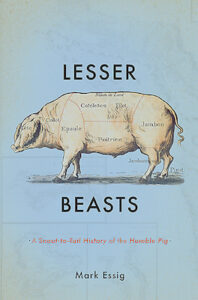It was with no small amount of wholly unintentional irony that I began reading Mark Essig’s Lesser Beasts; A Snout-to-Tail History of the Humble Pig while eating a ham sandwich. Such is the ubiquity of pigs. Yet for all the many ways the lives of modern humans have and to this day continue to intersect with the domesticated version of Sus scrofa, the European Wild Boar, most of us – even those who count ourselves naturalists – give little, if indeed any, thought to the natural history of the pig. Just as we do with most of the other creatures both wild and domestic that have long lived in close proximity to us, we too often fail to perceive just how much or for how long pigs have played important roles in the collective life of our own species. Perhaps that is why I found Essig’s book so utterly engrossing; it not only brought to my attention a wealth of information previously unknown to me, it helped me to understand just what amazing creatures pigs are.
At least as intelligent as dogs, the pig has a history that has been intertwined with humans for thousands of years. However unlike dogs, pigs – as Essig explains – essentially self-domesticated. Finding the rubbish piles around human settlements an easy source of food, the omnivorous pigs became the first animal after dogs to become habituated to life around humans. Yet while the dog was to become a valued and trusted – even essential – member of the family, the pig was to variously assume the less pleasant roles of garbage disposal, food source, and pariah.
From his explanation of just how pigs came to be considered “unclean” in some cultures – an explanation, by the way, which superbly answers this often asked question – to his recounting of the transition of the pig from the forest to the village and even the city, to his portrait of the pig as a highly modified commodity in the world of modern industrial agriculture, Essig’s prose is conversational and familiar. As a result, even when he is presenting material regarding the history such weighty subjects as the Roman empire or the Industrial Revolution, at no point did I ever find myself thinking “yes, yes… get on with it;” however more times than I can recall I found myself uttering exclamations such as “fascinating!” or “brilliant!” (Indeed, while reading the book in preparation for this review I brought up things I’d read in it so frequently at our family dinner table that I am certain that my wife and daughter were beginning to think I was developing some form of pig-related mania.”)
What did concern me most as I read through the book was the worry that, given all of Essig’s discussion of the adaptability and intelligence of pigs, as well as some of their unsettlingly similar physiology to humans (their teeth, for example, or the comparison to the taste and texture of their flesh to that reported in historic writings recounting episodes of human cannibalism), that at some point prior to the book’s conclusion it would devolve into a plea against their being raised for meat or eaten at all. However far from any such simplistic and predictable ending, Essig instead, after a thorough explanation of the realities of industrial agriculture and its effects upon both pigs and humans, turns to examples of how the raising of pigs can be and is being done in ways that allow the pigs so kept to live healthy lives, and the humans – both those who raise and well as those who eat them – to do so in ways that are also more physically and well as psychologically healthy as well.
Mark Essig’s Lesser Beasts is an informative as well as maturely insightful work wrapped in a package of friendly, conversational prose that leaves the reader both equally delighted and enlightened. And as any truly great book does, it leaves lasting effects upon the reader. Already I have found myself – solely due to what I read in its pages – correcting my words when tempted to refer to greedy behavior as “piggish” or someone whose actions I consider crude or slovenly as a “pig.” I now simply have too much understanding of and respect for these so called lesser beasts (pigs, that is) to do so in good conscience.
 Title: Lesser Beasts; A Snout-to-Tail History of the Humble Pig
Title: Lesser Beasts; A Snout-to-Tail History of the Humble Pig
Author: Mark Essig
Publisher: Basic Books
Format: Hardcover
Pages: 320 pp.
Published: 5 May 2015
ISBN 13: 978-0-465-05274-5
In accordance with Federal Trade Commission 16 CFR Part 255, it is disclosed that the copy of the book read in order to produce this review was provided gratis to the reviewer by the publisher.
